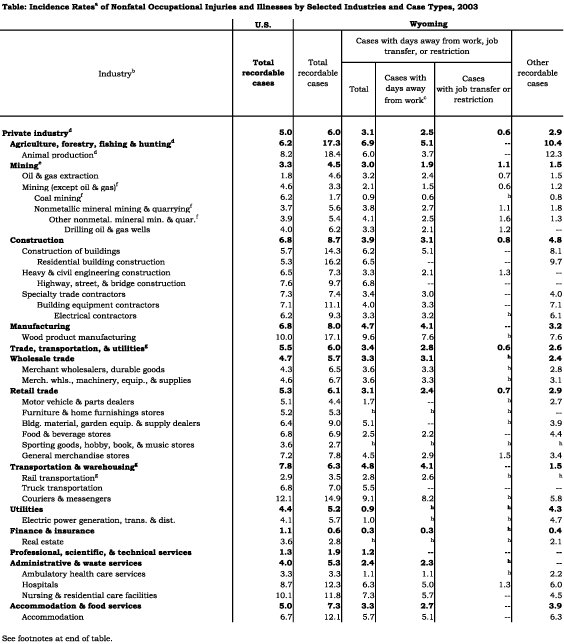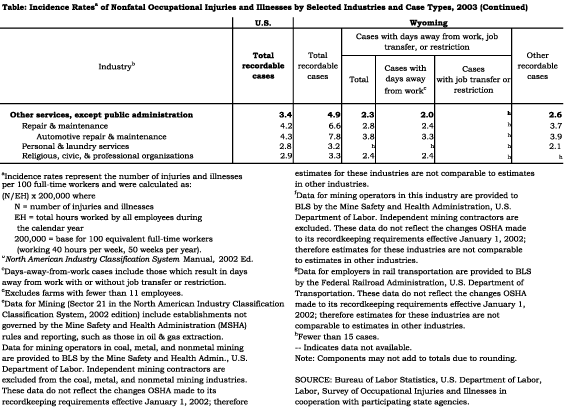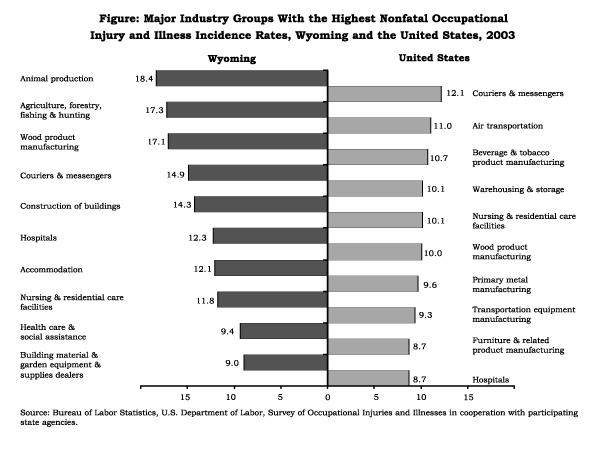
© Copyright 2005 by the Wyoming Department of Employment, Research & Planning
WYOMING LABOR FORCE TRENDS
Vol. 42 No. 2
The Survey of Occupational Injuries and Illnesses for 2003
by: Valerie A.
Davis, Economist
In 2003 Wyoming’s highest nonfatal occupational injury and illness incidence rate in a major industry group occurred in animal production, while couriers & messengers had the highest in the nation as a whole.
Research & Planning (R&P) conducts the annual Survey of Occupational Injuries and Illnesses in cooperation with the U.S. Bureau of Labor Statistics
(BLS). Wyoming-specific data assist local employers and safety awareness groups in identifying trends and areas where additional safety training may be beneficial. In this article, we present incidence rates of nonfatal occupational injuries and illnesses in Wyoming for 2003.
Background
The Occupational Safety and Health Administration (OSHA) requires a sample of private industry employers to track work-related injuries and illnesses by maintaining OSHA 300 forms. At the end of the year, employers use selected data from these OSHA forms to complete the annual survey. A work-related injury or illness is considered recordable on the OSHA 300 form if it results in one or more of the following:
l
Death
l Days away from work
l Restricted work or transfer to another job
l Medical treatment beyond first aid
l Loss of consciousness
l A significant injury or illness diagnosed by a physician or other licensed health
care professional
The Survey of Occupational Injuries and Illnesses is required by law. However, only a portion of Wyoming’s employers are selected to participate. Approximately 2,500 companies were randomly selected to participate in the 2003 Annual Survey.
While the sample selection was random, the structure of Wyoming’s industry composition may have influenced the types of firms surveyed. For example, three-quarters of Wyoming’s firms have fewer than 10 employees
(Leonard, 2005). Therefore, the survey sample included many small companies. The 2003 survey included 1,404 firms with fewer than 10 employees (or just over 56% of the total number of companies surveyed). In addition, the survey samples companies based on industry. Consequently, the more employees an establishment has, and the fewer firms within its industry, the greater the likelihood of being surveyed.
R&P surveyed employers regarding their 2003 workplace injury data in early 2004. Of selected Wyoming employers, 98 percent completed the mandatory survey by the August 2004 deadline. To provide customers with more timely data, the BLS has moved up deadlines and release dates in 2005.
The data utilized in this report are the summary data. The case and demographic data, published by the
BLS, are details on case characteristics (nature of the injury or illness, part of body affected, event or exposure, and primary and secondary sources of the injury or illness) of the workers and the demographic characteristics (occupation, age, gender, race, and length of service) of the more seriously injured and ill workers. More seriously is defined as involving days away from work.
Methodology
The BLS determines incidence rates from the gathered data. Incidence rates by industry record the number of illnesses or injuries per 100 employees. National rates are also determined from standard surveys conducted throughout the country. Through the states’ efforts, the BLS gathers employer data including the number of days away from work an employee took for a work-related accident or illness. The day of injury and the day the person returned to work are not counted. Also, days beyond 180 (per case) are not counted. Another data element is the Other Recordable case. This type of injury or illness did not require days away from work, days of job transfer, or restriction, but did require medical treatment beyond first aid.
Every year the BLS strives to conduct the survey in the same way. However, changes in recordkeeping requirements, like the classification codes for occupations or industries and additional columns on the forms such as for hearing loss (in 2004), may occur.
For 2003, survey results were based on the North American Industry Classification System
(NAICS) codes. Prior to 2003, Standard Industrial Classification (SIC) codes were used. The source used to code the occupations in 2003 was the Standard Occupational Classification (SOC) system, now used by most federal statistical programs. Prior to 2003, the Occupational Injury and Illness Occupational Coding Manual was used. These changes, along with changes in 2002 recordkeeping requirements, represent a time-series break in the data preventing over-the-year comparisons from 2001 to 2003. However, same-year comparisons between Wyoming, other states, and the U.S. are possible.
Findings
From the collection results for the year 2003, Wyoming’s highest nonfatal occupational injury and illness incidence rate in a major industry group occurred in animal production (18.4 per 100 full-time employees). For the United States, couriers & messengers had the highest incidence rate at 12.1 (see
Figure).
Five of the ten industry groups with the highest incidence rates in the U.S. are associated with various types of manufacturing. The 10 industry groups with the highest incidence rates in Wyoming are associated with a much wider range of industries such as Agriculture, Health Services, and Construction. The low rate of incidences in Wyoming’s Manufacturing industry is likely due to Wyoming’s underrepresentation of employment in Manufacturing compared to the U.S.
(Harris, 2002).
The Table shows the incidence rates for Wyoming and the U.S. for the major industries and some selected sub-industries. Data corresponding to the U.S. industries shown in the Figure are not listed separately in the Table because Wyoming had no publishable data at the same level of industry detail as the U.S. However, comparing total recordable cases for the U.S. and Wyoming, the incidence rates of nonfatal injuries and illnesses is higher for Wyoming in animal production (18.4 incidences per 100 employed in Wyoming compared to 8.2 for the U.S.); agriculture, forestry, fishing, & hunting (17.3 in Wyoming compared to 6.2 in the U.S.); and wood product manufacturing (17.1 in Wyoming compared to 10.0 in the U.S.). The two industries with the highest incidence rates in Wyoming are typically associated with more rural economies.
In mining (except oil & gas), Wyoming has a smaller incidence rate (3.3) compared to the U.S. (4.6). The difference in incidence rates is likely due to the difference in how mining is performed (primarily surface mining in Wyoming compared to more underground mining in other areas of the U.S.), but it could also imply that Wyoming companies in this industry use more safeguards than other firms outside Wyoming.
Within Wyoming’s service-providing sub-industries, the accommodation industry had an incidence rate of 12.1 per 100 full-time workers, well above the 6.7 reported for the U.S. The BLS reported that Wyoming hospitals showed an incidence rate of 12.3 compared to 8.7 for the U.S.
Future Research
Linking the Occupational Injuries and Illnesses Survey data with other administrative databases such as Wage Records would provide new avenues for labor market research. For example, we could study the relationship between access to employer-provided healthcare benefits, Worker’s Compensation claims by firm, and work-related injuries and illnesses. This area of study would allow us to determine whether there are more Worker’s Compensation claims among firms that do not offer health insurance.
Conclusion
The results of the survey may provide employers with an indication of the effectiveness of their safety programs. By using several years of survey data, Wyoming employers and safety awareness organizations could target problem areas and customize training programs.
References
Harris, M. (2002). Is Wyoming’s economy diversifying and is economic diversity in Wyoming desirable? Wyoming Labor Force Trends. Retrieved March 3, 2005, from http://doe.state.wy.us/LMI/0902/toc.htm
Leonard, D. (2005). Structure of compensation and the potential
Wyo-Care market. In Gallagher, T., Harris, M., Hiatt, M., Leonard, D., Saulcy, S., &
Shinkle, K. R., Private sector em-ployee access to health insurance and the potential
Wyo-Care market (pp. 1-134). Casper, WY: Wyoming Dept. of Employment, Research & Planning.
U.S. Department of Labor. Bureau of Labor Statistics. (n.d.).
Injuries, illnesses, and fatalities. Retrieved December 20, 2004, from http://www.bls.gov/iif/home.htm


Table of Contents | Labor Market Information | Wyoming Job Network | Send Us Mail
These pages
designed by Julie Barnish.
Last modified on
by Susan J. Murray.